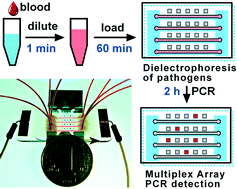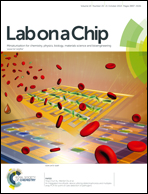An integrated microfluidic device utilizing dielectrophoresis and multiplex array PCR for point-of-care detection of pathogens†
Abstract
The early identification of causative pathogens in clinical specimens that require no cultivation is essential for directing evidence-based antimicrobial treatments in resource limited settings. Here, we describe an integrated microfluidic device for the rapid identification of pathogens in complex physiological matrices such as blood. The device was designed and fabricated using SlipChip technologies, which integrated four channels processing independent samples and identifying up to twenty different pathogens. Briefly, diluted whole human blood samples were directly injected into the device for analysis. The pathogens were extracted from the blood by dielectrophoresis, retained in an array of grooves, and identified by multiplex array PCR in nanoliter volumes with end-point fluorescence detection. The universality of the dielectrophoretic separation of pathogens from physiological fluids was evaluated with a panel of clinical isolates covering predominant bacterial and fungal species. Using this system, we simultaneously identified Pseudomonas aeruginosa, Staphylococcus aureus and Escherichia coli O157:H7 within 3 h. In addition to the prompt diagnosis of bloodstream infections, this method may also be utilized for differentiating microorganisms in contaminated water and environmental samples.


 Please wait while we load your content...
Please wait while we load your content...